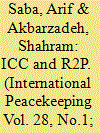| Srl | Item |
| 1 |
ID:
177850


|
|
|
|
|
| Summary/Abstract |
The ICC and R2P share the goal of ending atrocity crimes. Nonetheless, they operate quite differently. Recently, there has been increasing support for bringing the ICC within the R2P toolkits, hoping they will complement each other to achieve their shared goal. The Security Council put this idea into practice to deal with the 2011 crisis in Libya. However, the invocation of ICC against the backdrop of an evolving military intervention under the R2P mandate highlighted significant risks to its integrity and legitimacy. This paper argues that the invocation of ICC to constrain violence and to hold accountable the Libyan regime for atrocity crimes eventually resulted in legitimizing military intervention and regime change under the R2P mandate. The Libya case suggests that neither the push for complementarity nor a full separation between the ICC and R2P benefits the ICC. There needs to be a balance between full engagement and separation. Such an alternative rests on the ICC avoiding entanglement with R2P’s military mandate, while maintaining close interaction with its non-military components through the Security Council. Lastly, the paper also points to areas in which the Council could play a more constructive role in cementing greater cooperation between R2P and the ICC.
|
|
|
|
|
|
|
|
|
|
|
|
|
|
|
|
| 2 |
ID:
158107


|
|
|
|
|
| Summary/Abstract |
There is a widespread assumption that, given the imminent threat of mass atrocities against the Libyan civilians – especially in Benghazi – and in the absence of non-military alternatives, military action against the regime of Muammar Gaddafi was a justified and necessary response. This paper challenges this widespread assumption. It argues that on the eve of NATO-led military intervention, there was no ‘clear evidence’ to suggest that the Libyan regime was on the verge of committing mass atrocities against civilians. This research also documents the range of political and diplomatic options open to the international community to engage with Gaddafi, all of which were sidetracked in favour of military action. Despite the brutality of Gaddafi’s rule, military intervention in Libya did not meet the Responsibility to Protect’s (R2P) ‘just cause’ and ‘last resort’ criteria. Far from being a successful application of R2P’s most coercive pillar, the Libyan case was a manifest misapplication of R2P's military component. An objective analysis of the Libyan crisis during February and March 2011 should have prevented the use of military force.
|
|
|
|
|
|
|
|
|
|
|
|
|
|
|
|